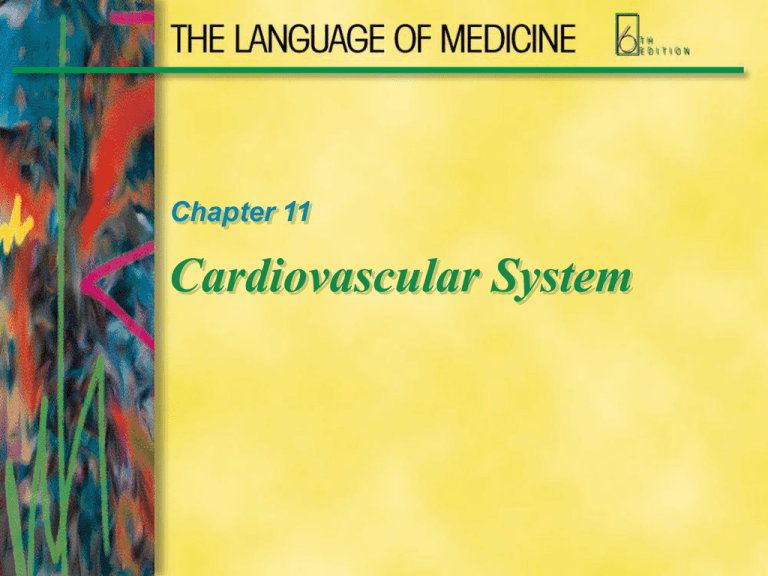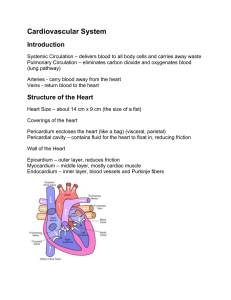
Chapter 11
Cardiovascular System
Cardiovascular System
• Blood Vessels- (angi/o); (vas/o; vascul/o)
– 1. Arteries (arter/o; arteri/o)
• The large vessels that lead away from the heart
• Walls of are made of connective tissues, muscle
tissue, elastic fibers, and epithelial cells
• Elastic walls allow for expansion as heartbeat
forces blood into the system
• Small branches of arteries are called arterioles.
Arterioles are thinner and carry blood to the
tiniest of blood vessels, the capillaries
Arterial Conditions in Blood vessels
•
•
•
•
•
•
Aneurysm- a local widening of an artery
Hypertension- high blood pressure
Peripheral vascular disease- claudication
Raynaud phenomenon
Embolus- floating blood clot or other
material in the vessel
Atherosclerosis- hardening of the arteries
caused by fatty or calcium deposits in the
artery walls causing them to thicken
Pulmonary Embolism
Atherosclerosis.
Fig. 11-11.
(Modified from Kumar V, Cotran R, Robbins SL: Basic Pathology, 6th ed.
Philadelphia, WB Saunders, 1997, page 319.)
Copyright © 2001 by W. B. Saunders Company. All rights reserved.
Back
MENU
Forward
Capillaries
• Walls are only one endothelial cell thick
• Carry nutrient-rich, oxygenated blood from
the arteries and arterioles to the body cells
• Waste products (CO2 and H2O) pass out of
the cell and into the thin-wall capillaries
• Waste-filled blood then flows back to the
heart in venuoles, which branch to form
veins
Veins (phleb/o; ven/o)
•
•
•
•
Thinner walled than arteries
Conduct blood toward the heart from the tissues
Lower pressure than arteries
Veins have valves to prevent backflow of blood
and keep the blood moving in one direction
• Muscular action helps movement of blood
• Varicose Veins
Phlebitis- inflammation of a vein
Phlebotomy- incision of a vein
Blood vessels.
(Some parts modified from Damjanov I: Pathology for the Health-Related Professions.
Philadelphia, WB Saunders, 1996, page 155.)
Copyright © 2001 by W. B. Saunders Company. All rights reserved.
Back
MENU
Fig. 11-1.
Forward
Anatomy of the Heart
• Heart- (cardi/o; coron/o)
• It is a two-sided double pump;
– Rt side of heart send O2 deficient blood to lungs
where the blood picks up O2 and releases CO2
– O2 rich blood returns to left side of heart and left
side of heart pumps blood to rest of the body
• Size of your fist
• Lies in the thoracic cavity
• Four Chambers:
– Two upper chambers called atrium
– Two lower chambers called ventricles (ventricul/o)
Anatomy of the heart
• Four Valves; (valvul/o; vavl/o) –cusps or
flaps of valves
– Tricuspid- b/w rt atrium and rt ventricle
– Pulmonary- b/w rt ventricle and pulmonary
artery
– Mitral- b/w left atrium and left ventricle
– Aortic- prevents return of aortic blood to left
ventricle
• Patent= to open
Anatomy of the heart
• Septum- divides the right side of the heart from
the left side; wall or portion within heart
• Three layers of the heart:
– Endocardium- smooth cells that line the inside of
the heart and valves
– Myocardium- the thickest layer, consists of muscle
tissue; this layer pumps blood throughout the body
– Pericardium (pericardi/o)- double membrane that
covers the outside of the heart. Prevents damage
from ribs and surrounding structures (“pads the
heart”)
*Cardiomyopathy- disease of heart muscle
The walls of the heart and pericardium.
Fig. 11-5.
Copyright © 2001 by W. B. Saunders Company. All rights reserved.
Back
MENU
Forward
The aorta and arteries.
Fig. 11-3.
Copyright © 2001 by W. B. Saunders Company. All rights reserved.
Back
MENU
Forward
Structure of the heart.
Fig. 11-4.
(Modified from Damjanov I: Pathology for the Health-Related Professions.
Philadelphia, WB Saunders, 1996, page 154.)
Copyright © 2001 by W. B. Saunders Company. All rights reserved.
Back
MENU
Forward
Pulmonary Circulation
•
•
•
•
Superior and Inferior Vena Cava
Right Atrium
Tricuspid Valve
Right Ventricle
•
•
•
•
•
•
•
•
•
•
Pulmonary Valve
Pulmonary Artery
Lungs
Pulmonary Vein
Left Atrium
Mitral Valve
Left Ventricle
Aortic Valve
Aorta (aort/o)
To body
Systemic Circulation
• O2 rich blood leaves heart thru the aorta
the largest artery in the body
• Ascending aorta
• Descending aorta
• Arteries
• Arterioles
• Tissue Capillaries
• Venules
• Veins
• Superior and Inferior Vena Cava
Pathway of blood through the heart.
Fig. 11-6.
Copyright © 2001 by W. B. Saunders Company. All rights reserved.
Back
MENU
Forward
Physiology of the Heart
•
Heartbeat (2 phases)
1. Diastole= relaxation
– Blood comes from the vena cava and
pulmonary veins
– Tricuspid and mitral valves open
– Pulmonary and aortic valves closed
2. Systole= contraction phase of heart
- Ventricles contract to pump blood via
pulmonary artery and aorta
- Tricuspid and mitral valve are closed
Phases of the heartbeat.
Fig. 11-7.
Copyright © 2001 by W. B. Saunders Company. All rights reserved.
Back
MENU
Forward
Physiology of Heart
• Diastole-Systole Cycle
– 70-80 times per minute
– 5 quarts of blood per minute
– 75 gallons per hour
– 2000 gallons per day
Heart Sounds
“lub” sound= closure of tricuspid valve and mitral
valves at the beginning of systole and is first heart
sound
“dub” sound= closure of aortic and pulmonary valves
at end of systole and is second heart sound
“murmur”= abnormal heart sound
Physiology of heart
• Conduction System
– Sinoatrial Node (SA node)= pacemaker of
the heart; sensitive tissue in the rt atrium
wall that begins the heart beat
• Posterior of rt atrium
• Electrical impulse
• Atria contracts and force blood into the
ventricle
Physiology of Heart
• Atrioventricular Node- (AV node)= sends
the electrical wave to the Bundle of HIS
(muscle fibers); located in posterior portion
of inter-arterial septum
• Bundle of HIS= divides right and left bundle
branches to the ventricle walls and
stimulate them to contract
• Systole occurs and blood is pumped away
from the heart
• Diastole= short period of rest
A) Conduction system of the heart.
B) Electrocardiogram.
P wave= spread of excitation
over atria before contraction
QRS wave= spread of excitation
over ventricles as contraction
occurs
T wave= electrical recovery and
relaxation of ventricles
Figs. 11-8 / 11-9.
(Part B from Applegate MS: The Anatomy and Physiology, 6th ed.
Philadelphia, WB Saunders, 1997, page 253.)
Copyright © 2001 by W. B. Saunders Company. All rights reserved.
Back
MENU
Forward
Blood Pressure
• Blood pressure= force that the blood exerts on
the arterial walls
– Sphygmomanometer- a device to measure blood
pressure (sphygm/o=pulse)
– Auscultation- to listen with a stethoscope
– First sound= systolic pressure (pressure in the
artery when the left ventricle is contracting to force
the blood into the aorta); pumping blood to the
body
– Second sound= diastolic blood pressure (pressure
in the artery when the ventricles are relaxing and
the heart is filling); when the heart relaxes
– Written as a fraction: 120/80= systolic/diastolic
Pathological Conditions
• Ischemia- can lead to a Myocardial Infarction
(MI); blood held from an area and can be caused
by thrombotic occlusion of a blood vessel
• Arrhythmia- abnormal heart rhythms
– Heart block (AV block); failure of proper
conduction of impulses thru AV node to AV Bundle
of HIS; pacemakers can help
– Flutter- rapid but regular contraction of atria or
ventricles
– Fibrillation- rapid, random, ineffectual contraction
of the heart
– Palpitations- uncomfortable sensations in the
chest
Pathological Conditions
• Congenital Heart Disease- abnormalities in
the heart at birth
– Coarctation of the Aorta (CoA)
– Patent ductus arteriosus (PDA)
– Septal defects- sm holes in the septa b/w
atria or ventricles
– Tetralogy of Fallot (pg 389)
• Pulmonary artery stenosis
• Ventricular septal defect
• Shift of aorta to the right
• Hypertrophy of right ventricle
Pathological Conditions
• Endocarditis- inflammation of inner lining of
heart due to bacteria
• Congestive Heart Failure- heart is unable
to pump required amount of blood
• Coronary Artery Disease- (CAD); blockage
of arteries surrounding the heart and leads
to ischemia
– MI= Myocardial Infarction (Heart Attack)
– Angina pectoris= chest pain; nitroglycerin
can help: vasodilator (relaxes vessels)
Endocarditis
Coronary Artery Disease
Pathological Conditions
• Hypertensive heart disease- high blood
pressure
• Mitral Valve Prolapse (MVP)- improper
closure of the mitral valve
• Murmur- extra heart sound between beats
• Pericarditis- inflammation of membrane
surrounding heart
• Rheumatic heart disease- heart disease
caused by strep infection
• Cyanosis- bluish coloration of skin
Mitral Valve Prolapse
Rheumatic Heart Disease
PetechiaePinpoint
hemorrhages
(epicardium of
heart)
Often due to low
platelet count.
http://www-medlib.med.utah.edu/WebPath/ATHHTML/ATH035.html
Laboratory Tests
• Serum Enzyme- when the heart is
damaged the tissues release enzymes into
blood stream
– CPK-creatine phosphokinase
– LDH- lactate dehydrogenase
• Lipoprotein electrophoresis- proteins that
carry lipids in blood steam (LDL& HDL)
• Lipid tests- tests amount of cholesterol and
triglycerides
– Lipids are fatty substances found in foods
Laboratory Procedures
• Ultrasound– Doppler ultrasound: sound waves on a blood
vessel
– Echocardiography (ECHO)- pulses of highfrequency sound waves and shows valves,
chambers, and surfaces of the heart
• X-Ray
– Angiography- dye injected into blood steam and xray taken of heart and vessels
– Digital subtraction angiography (DSA)x-ray done then dye injected and x-ray taken; a
comparison is then done
Echocardiography
Echocardiogram
Procedures
• MRI- Magnetic Resonance Image; beamed
at heart and image is produced
• Nuclear Cardiology
– Positron Emission Tomography (PET)- IV
radiopharmaceutical and glucose injected
then images are made; localizes in the
myocardium
– Thallium 210 Scintigraphy- radioactive
isotope given IV; taken up by myocardial
tissue and then scarred tissue does not
extract the isotope
Procedures
• Cardiac Cath- incision in the groin and a catheter
is threaded into the circulatory system to the
heart
• Cardioversion (defibrillation)- discharge of
electricity applied across the chest to stop
arrhythmia
• Coronary Bypass surgery- (CABG) vessel grafts
are anastomosed to detour around blockages
• Electrocardiography (EKG,ECG)- recording of the
electricity of the heart
– Normal sinus rhythm= normal heart beat
Cardiac Catheterization
Procedures
• Endarterectomy- surgical removal of the
innermost lining of an artery
• Heart Transplantation- a donor heart is
transferred to recipient
• Holter Monitoring- monitor attached to chest to
record cardiac activity for 24 hours and an EKG is
taken during daily activities
• Stress Test- determines the heart’s response to
physical exertion
• Thrombolytic therapy- drugs used to dissolve
clots; must be done within 12 hours after the
onset of a heart attack (thromb/o=clot)
Abbreviations
•
•
•
•
•
•
•
•
•
•
•
•
•
•
•
•
AV
BP
CABG
CAD
CCU
Cath
CHF
CPK
DVT
ECG, EKG
ECHO
HDL
LDL
LDH
MI
VT
Scenario
• Mr. AchyBrachyHeart was seen by the EMT’s and
found to have tachycardia. Lidocaine (a cardiac
antiarrhymic drug) was started and by the time he
reached the ER his HR was 75-80 bpm with a
normal sinus rhythm. BP was 156/88. He had a
good carotid pulse bilaterally. No cardiomegaly
and no murmurs.
• He was started on a cardiac monitor and
observed for any EKG change. He had no
episodes of hypotension and no further
arrhythmia. There was no evidence to do cardiac
enzyme studies and patient was discharged.
Coronary artery bypass graft (CABG) surgery.
Fig. 11-23.
Copyright © 2001 by W. B. Saunders Company. All rights reserved.
Back
MENU
Forward
Placement of an intracoronary artery stent.
Fig. 11-25ABC.
Copyright © 2001 by W. B. Saunders Company. All rights reserved.
Back
MENU




